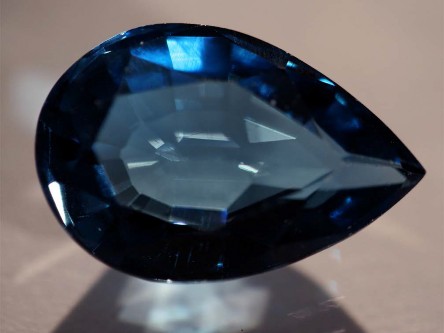
Introduction to Gemology Course
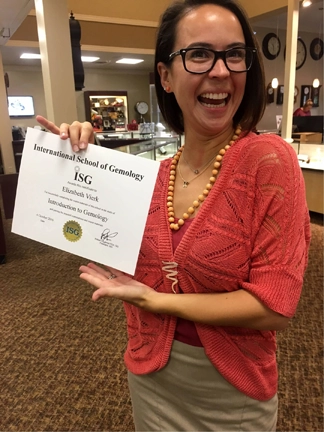 The Introduction to Gemology Course has been designed explicitly as a foundation study of gemology for those just starting their gemstone careers. This foundation course includes information taken directly from the ISG Registered Gemologist Appraiser program and more. It is designed for those without gemology experience to gain a foundation knowledge in gemology to serve their future learning needs.
The Introduction to Gemology Course has been designed explicitly as a foundation study of gemology for those just starting their gemstone careers. This foundation course includes information taken directly from the ISG Registered Gemologist Appraiser program and more. It is designed for those without gemology experience to gain a foundation knowledge in gemology to serve their future learning needs.
This program consists of a 9-lesson course in gem and mineral formation, how gemstones are mined, how gemstone crystals grow, basics of gem identification, a review of over 67 of the most often seen gemstones, and a full section on Careers in Gemology.
Here is an overview of the course program:
- Lesson One: How Gemstones Form
- Lesson Two: Gems from Igneous Rocks
- Lesson Three: Gems from Metamorphic Rocks
- Lesson Four: Gems from Sedimentary Rocks
- Lesson Five: The 7 Crystal Systems
- Lesson Six: Review of Gemstones A – L:
- Lesson Seven: Review of Gemstones M – Z
- Lesson Eight: Gem Identification, videos demonstrating optical properties, how to use the gem equipment and gemstone phenomena.
- Lesson Nine: Careers in Gemology
This course includes over 200 photographs and 25 video demonstrations to help you begin your study of gemology. Great for anyone interested in gems and minerals and the study of gemology but not yet ready to take a complete program study in gemology.
Tuition: $95.00
How to Begin to Start Immediately
- To pay a one-time tuition payment and begin immediately, use any credit card on PayPal or our new STRIPE Credit Card Payment Gateway.
- SSL Secure Payments can be made through STRIPE or PAYPAL.
- Click on the BUY NOW button on the upper right side of this page.
- The payment gateway will take you to the payment system icon.
- Once you receive payment confirmation, you will be brought back to your course or to the Gemology.pro website to begin. Either way, go to the course home page to begin. You can also access the course page through your Profile Page, which is available under your username in the top right corner of the home page.
- Once you have returned to the course home page, click the Start the Course button to begin immediately.
- Once you complete the program, you will receive your Introduction to Gemology Certificate by mail. International students will receive your certificate via email on PDF.
Introduction to Gemology Course
Your Instructor: Robert James FGA, GG
Welcome to the ISG Introduction to Gemology Course.In this course, we are going to explore how rocks and minerals form, learn about gems and minerals from the various groups, and do some fun projects to help you understand how much you can learn about gems and minerals from right in your own area. We will begin by learning about minerals.
Lesson 1: How Rocks Form
What is a mineral?

A mineral is a single substance made of one ingredient. An example is the copper you see above. Copper is a mineral, and is also used to make the US pennies and coins from other countries as well.
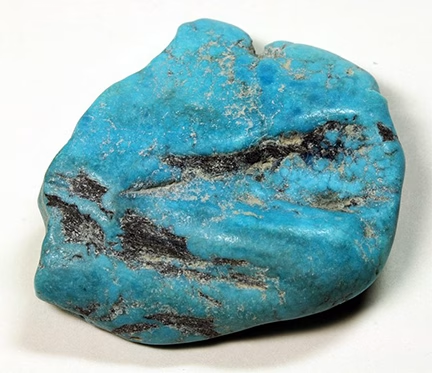
A mineral can also be a combination of substances that form a group of elements, such as the turquoise gemstone you see above. Here, the copper is joined with oxygen and water to form turquoise. Turquoise is a mineral that contains copper.
What is a rock?

A rock is formed from a combination of minerals. An example is the blue lapis lazuli you see above. Although world famous as a gemstone, lapis lazuli is a rock. A rock that formed from more than one mineral joining together to form a group of minerals. Most minerals used for gemstones will be found in rocks. Before we begin a study of minerals, let’s learn about how rocks form. This will help us to understand better how we get gemstones, as minerals, from rocks.
How rocks form?
Rocks form in one of three categories:
- Igneous
- Metamorphic
- Sedimentary
Below is a graphic to help you understand where these rocks can form. This demonstrated the cycle of rock formation.
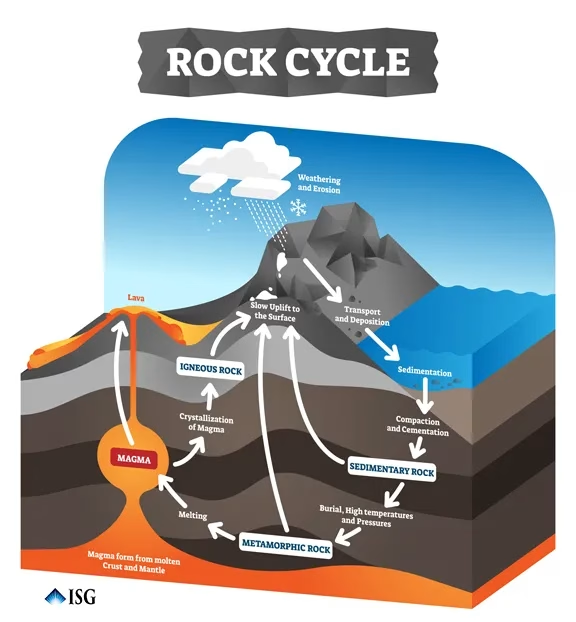
This simple graphic shows you where most rocks form. The igneous rocks are due to molten rock, known as magma, moving to the surface where it cools to form igneous rocks. Metamorphic rocks form when igneous, sedimentary, or other metamorphic rocks are put under great pressure and heat that causes them to change form. Sedimentary rocks form at the bottom of the ocean or lakes because sediments are under great pressure and forming rock layers. Let’s look at some examples…
IGNEOUS ROCK FORMATION
Magma -v- Lava
Igneous rocks form when molten rock cools on the surface of the earth. When the molten rock is on the surface of the earth it is known as lava. However, in many cases, the molten rock cools while it is still deep inside the earth. Molten rock deep inside the earth is known as magma. Both are composed of molten rock, but the location of that molten rock when it cools will determine the name used to describe it. The important part is that both lava on the surface and magma below the surface cool to form igneous rocks. Igneous rocks are formed when lava or magma cools and hardens.
In our study, we will first look at igneous rocks formed from lava.
Eleven million years ago, a series of fissures opened in the surface of the earth on the eastern portion of the State of Oregon in the United States. Large volumes of molten lava poured out from these fissures, covering the land many meters thick.
Many different flows at different times in various areas created layers of igneous rocks across what is now known as the Oregon High Desert. The desert is almost 2500 feet (725 meters) high and is due to layer upon layer of molten lava flowing out over the land and cooling to form layers of igneous rocks.
These lava flows built up to be very thick layers of igneous rocks.
Here you see a very thick and dark area that is almost 2,500 feet (762 meters) that was once molten lava. This lava flowed from deep inside the earth out onto the plains of Oregon in the USA, and then cooled to form a very thick layer of igneous rock that you see.

Above is a closer view of another of these layers of igneous rock that were formed by cooling lava. The rock is eroding due to wind and rain. When the water from rain freezes inside the rocks during the winter, it causes the rocks to crack and break. When the summer sun warms the rocks, it makes them expand and break apart along the cracks. When this happens, the igneous rocks break apart and fall down the side of the formation as you see below.

Above is another view of a heavily eroded layer of igneous rock formed from cooled lava. This type of dark igneous rock is called basalt, a name it gets because of the minerals that it contains. Some individual lava flows cooled to form rock layers that are thin, while others formed very thick layers. The thicker lava layers cooled more slowly. The slower cooling rocks formed larger gemstone crystals since the slow cooling gave the crystals more time to grow.

Here is a look inside an igneous rock. There are two important features you should notice:
- The rock is very porous, meaning it has a lot of holes. This was due to a lot of gas being present in the lava when it cooled.
- The white-colored features are crystals that formed inside the lava rock as it slowly cooled. The slower the lava cooled, the larger the crystals can form due to slow cooling. This is how and where gemstones form in igneous rocks.
In the central part of Texas in the USA, there is a formation of igneous rock that is over 1 billion years old, much older than the surrounding sedimentary rocks that cover it. These igneous rocks were formed when magma tried to push up through the surface of the earth to become lava, but it became stuck and cooled just under the surface. This intrusion of magma that cooled very slowly allowed some very unusual crystals to form that are found nowhere else on Earth.
Most igneous rock formations that produce gemstones are formed by cooling magma instead of lava. The Oregon Sunstone deposits, found in the lava formed igneous rocks that we just studied, are very rare since lava cools typically too quickly for gemstone crystals to form. But in that case, the gemstones formed deep inside the earth in the magma chamber and then came to the surface with the lava.
Igneous rocks formed from magma, however, can produce large crystals of gemstones since the magma cools deep inside the earth which causes it to cool very, very slowly. This very slow cooling of molten rock allows for many gemstone crystals to form in very large sizes. It also allows for some very unusual crystal types to form since many of the ingredients or minerals found deep in the earth are rarely found on the surface. For this reason, magma-formed igneous rocks will quite often have gemstones that are totally unique to any other type of formation.
Below is one very rare example.

The formation you see at left is an exposed vein of what was once molten magma deep inside the earth. When erosion exposed the formation, and the roadway was cut through it, this exposed the billion-year-old igneous formation of an igneous rock known as granite and a very rare type of crystals that grew inside this magma formation billions of years ago.

When we look closer at the rock, it has blue crystals running through it. These blue crystals are quartz crystals. Quartz is another very common mineral found in the surface of the earth, but blue quartz of this type has never been found in any place but this one outcrop that crosses a road in Central Texas. Being close to the town of Llano, it is called “llanite” and is found in only one place on earth. A rare treasure that formed deep in the earth when a chamber of magma slowly cooled.
METAMORPHIC ROCK FORMATION
We sometimes have fun with metamorphic rocks by calling them “transformer” rocks, mainly because they do transform from one kind of rock to another. Another term is to “morph”, meaning change. Yet another way to look at it is with caterpillars “morphing” into butterflies. Butterflies start out as caterpillars and, after spinning a cocoon and living in it for a while, go through metamorphosis and turn into a butterflies. They change.
The same thing can happen to rocks, but it is done in a slightly different way. These rocks change from one type of rock to another type due to being exposed to very high heat and pressure.
Metamorphic rocks can start out being almost any kind of rock: igneous, metamorphic, or sedimentary. Any rock subjected to high heat and pressure can change or “morph” into another type of rock. An example is the marble in marble floors or tables. Sedimentary sandstone exposed to very high heat and temperature will morph into marble, as found in the famous marble quarries throughout Italy that made that country famous for marble statues and floors. Sometimes, rocks that are already metamorphic from a previous change can be changed again if exposed to heat and temperature later.
Regardless of what kind of rock was the original, metamorphic rocks can be the source of many gemstones. The reason is that a particular type of gemstone crystal may form during the morph of the rock at one stage, while another morph event in the rock can cause other gemstone crystals to form. This creates a rock that can offer many different types of gemstone crystals due to the many different times the rock has been changed from one type to another.
One of the most beautiful features of metamorphic rocks is the formations and shapes the rocks can create. While igneous rocks are formed from the cooling of molten rocks, which gives you the same appearance in most cases, metamorphic rocks offer a wide and wonderful variety of shapes and formations as the pressure and heat causes the rocks to move, curve, bend, and even twist.
The area around Mason County, Texas, offers some of the most beautiful metamorphic rock formations. A billion years ago, magma entered the area and either already existed or formed during this intrusion. The pressure and heat caused by the magma transformed or morphed the rocks.
Let’s look at some of the exceptional formations that these metamorphic rocks offer.
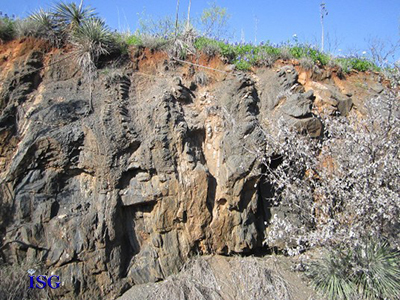
The heat and pressure of the magma pushing against the rocks already in the area bent, twisted, and folded them, as you can see on the right. These rocks became a type of schist called “Packsaddle Schist.” The magma formed the white granite intrusion rock, while the black rock is the metamorphic Packsaddle Schist formed due to the magma intrusion.

Above is another look at a section of this formation in Mason County, Texas. You can see the white granite intrusions. This contained hot water that was full of minerals that cooled to form natural blue topaz crystals found in this metamorphic rock. We will cover that in a later chapter. But the critical part of this image is that the intrusion of the hot, molten magma into the previously existing rock caused the rock to “morph” into the black schist you see here.
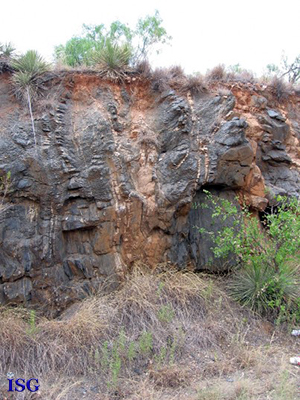
Here is another excellent view of the white granite intrusion and the black metamorphic rock that it caused to form. This all occurred deep underground over a billion years ago. The area was exposed over time due to erosion, and eventually, the Texas Department of Transportation cut through the formation to build a road. Road cuts are very important places to find unusual rocks.

Close to this intrusion is another interesting formation where the pre-existing rock was twisted and bent. Notice the lines in the rock at right. These were originally straight formation lines in this host rock, but the intrusion of magma a billion years ago heated the rock to almost molten and created so much pressure on the rock that it bent and twisted.

Here is an excellent view of the bending of the original rock formation. It is difficult to imagine the amount of heat and pressure that had to be put on this rock to make it soft enough to bend and twist in the manner shown by these images.
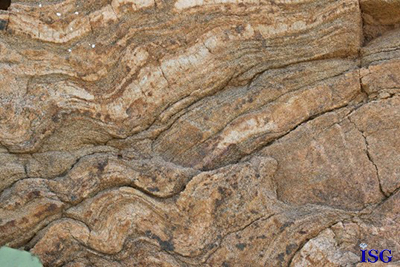
Here is another dramatic view above of this formation and the bending of the host rock that occurred during this magmatic intrusion. The pressure and heat required to turn these rocks into what would appear at the time to be like plastic is enormous.
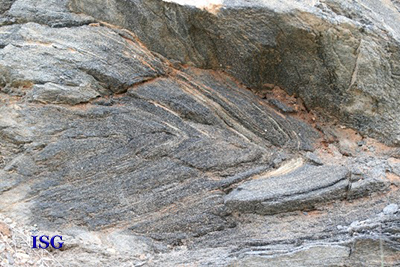
This image is one of the most famous formations in this location. Here, you can see that the Packsaddle Schist has been subjected to such heat and pressure from the intrusion of the magma that it folded the rock backwards. This rock layer was once flat. But the magma pushed so hard into the space this rock was already taking that the magma caused the rock to bend back as you see here.
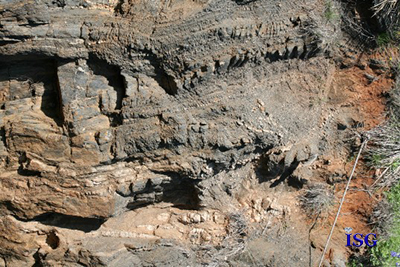
Many gemstones can form in one of these metamorphic formations since the heat and pressure will melt certain minerals and allow them to cool very slowly. This slow cooling of the minerals can allow for large crystals to grow in the metamorphic rock. Above, you see quartz veins that run through this Packsaddle Schist metamorphic rock. This was due to hot water being in the magma when it pushed into this rock. The hot water created a healthy environment for gemstone crystals to grow.

Above, you see large quartz crystals that grew inside this igneous rock when it was molten magma. The area where you see these crystals is the area where other crystals can grow and are often found. These include rubies, sapphires and many others. The pink rock around the edges of the quartz is feldspar, another type of gemstone when found in specific types.
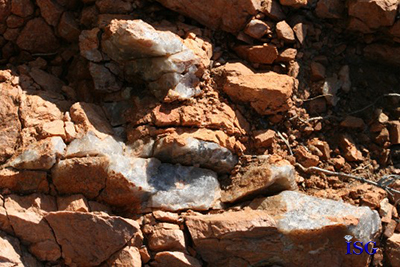
Finally, one more area of large quartz crystals in this metamorphic rock formation above. The magma had hot water full of all types of minerals in the mix. As the hot water cooled the minerals formed crystals based on what types of minerals were present. You can clearly see how these quartz crystals grew inside the metamorphic rock.
Let’s take a look at the Packsaddle Schist metamorphic rock.
SEDIMENTARY ROCK FORMATION
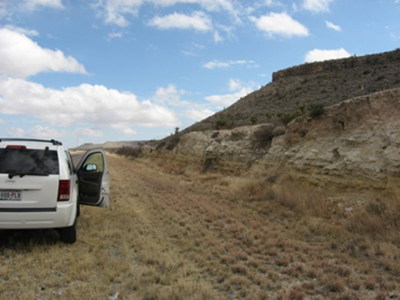
One of the best places to find sedimentary rocks is in road cuts through areas of sedimentary formations. As seen above in the Texas Hill Country, the roadway was cut through the sedimentary formation of rock that exposed literally millions of years of history on this roadway. If the correct level is exposed there can be many fossils found in this type of area.
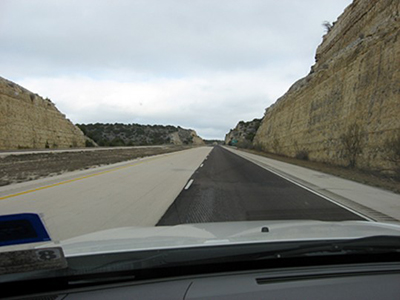
This road was cut deep through a hill that is in the Texas Hill Country between San Antonio and El Paso. The sides of the road cut are hundreds of feet high, and expose millions of years of geological history. You can see in the background of the image that there are many hills cut by this roadway. An excellent place to study the formation of sedimentary rocks.
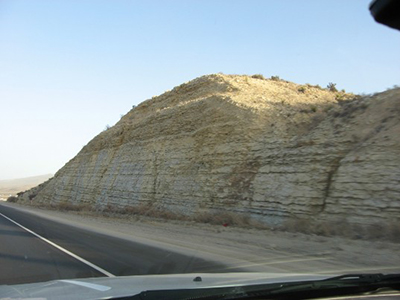
Cracks can be seen running through the sedimentary rock in the image at right. These fractures that run up and down through the sandstone show where “faulting” or breaking, has occurred over the life of this formation. This is due to shifting of the ground around the hill that caused the rock to break. This is a very small example of how fault lines can cause earth quakes.
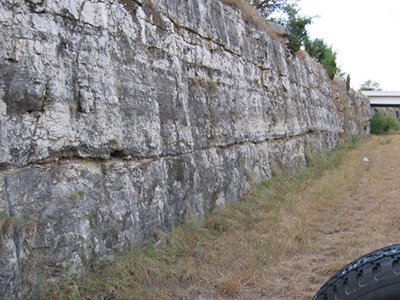
Road cuts like this one above, along Highway 1604 in San Antonio, Texas, can provide some beautiful insights into the local history. This area was uplifted almost 10 million years ago. The uplift was slow and uniform, which allowed the layers of the sedimentary rock to be raised without being disturbed. As a result, you have very even horizontal lines that expose the ancient sea floor sediments that are now sedimentary rocks.
These formations were very important to the Native Americans in this area. If you look up on the side of this sedimentary wall face, you will see what appears to be pinkish-brown dotted lines in the dark gray rock. These are nodules of flint used by the Native Americans to make tools and weapons. The small dotted lines of flint were ancient sea sponges and other creatures that lived in the ancient oceans when this area was underwater.
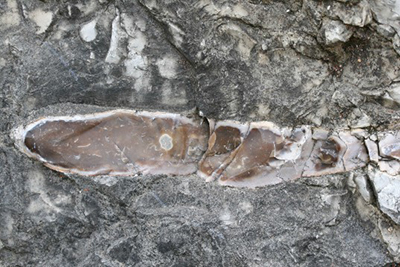
Here is a close-up of a flint nodule. Imagine this when it was a living sea sponge on the bottom of this ancient ocean that covered this area. The sea sponge died and was covered in the sand and silt from the water. As the sand was compressed into sandstone, the sea sponge body created this nodule of silicon-rich flint. This is the source of flint in this area that the Native American craftsmen used to make tools.

Another close-up of a flint nodule demonstrates the importance of this valuable artifact found in sedimentary rocks. This flint is so hard that it can be sharpened to an edge that is sharper than a scalpel used in hospitals. For this reason, we understand the importance of finding these formations to the Native Americans in the area.

On the left is a cutting tool made from one of these flint nodules and found in an area known to be used by the Native Americans for tools and weapons production. As you can see, the cutting edge was very sharp, and the chipped blade can be seen at the top of the image. When these chips occurred, the cutting tool did not work properly and was discarded. Above right is an arrowhead made from flint from an area around Wichita Falls, Texas. It was found in a field where the local Native American tribes fought many battles with the US Army over 150 years ago.
As you study gemology, it will be essential to remember the basics of how rocks and minerals form. This information will help you become a better gemologist since rocks and minerals are where gemstones are found, and understanding where they form will help you learn how to identify and grade gemstones better. This lesson sets the foundation for you to understand the formation of rocks and minerals. In the next lesson, we are going to take a tour of rocks and minerals to learn about specific examples that will help you further understand how rocks and minerals are essential to gemologists.
This concludes Lesson One: How Rocks Form. In the following sections, we will look at each type of rock formation to learn how gemstones form in each and how knowing the formation of gemstones in these rocks makes their identification easier.
This concludes Lesson One: How Rocks Form. In the next sections, we will examine each type of rock formation to learn how gemstones form in each and how knowing the formation of gemstones in these rocks makes their identification easier.
Self Assessment: Let’s test your knowledge of the material in this lesson.
Please disregard the “FINISH” button at the end of the quiz. This is a non-reported practice quiz.
